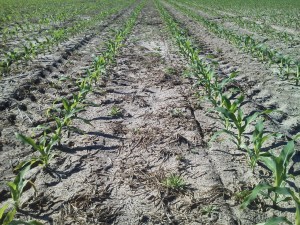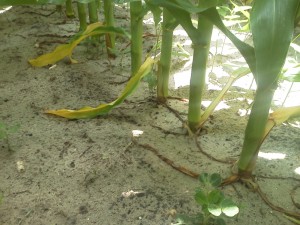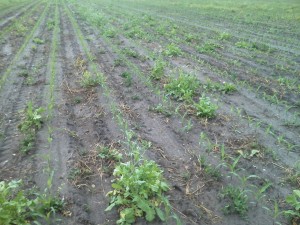
Corn stand with even emergence and uniform germination. This is in what I would call a moderate input program. However the stand still offers max yield potential.
I will begin by saying this has been the most stressful corn crop I have dealt with here in North Florida. This is not really because of the conditions, but because the Industry: academia, extension, media, sales, marketing, and the farmers have bought into the idea of 300 bushel corn across the board. I don’t know if my stress is because I am like Eeyore, the pessimistic, gloomy, gray stuffed donkey, or because I know you have to walk before you can run. My general observation is that we have a shot at making a good average; However, I am afraid that there will be a significant group of farmers who make good yields, but are overspending on their crop and won’t have a dime left at the end. Here are a few observations and interpretations at this point in the season.
Agronomics. Many of our farmers couldn’t get their desired hybrids due to short seed supply. They are wishing they could because the seed they recieved hasn’t impressed them like their favorite hybrids. Even if two hybrids yield the same in the end, sometimes one hybrid has the leaf architecture, growth rate, color, or any other factor that effects the appearance of the crop, and farmers just know what they want to see in a corn crop. Many of our farmers don’t have the planter for 300 bushel corn. It isn’t as easy as dropping 36-38,000 seeds, although some have done just that, with skips, doubles, and nonuniform emergence. We need to talk more about high quality corn planters, precision planting, and seed firmers. I am seeing more in-row variability this year, even where things were done right. I didn’t notice this as much at day 40 as I am at day 60.

Corn stand with uneven emergence and spacing. This is in what I would call an extremely high input program. I think the stand itself limits yield potential.
Weed Control. One word. Atrazine. If there is one good thing I can say it is at least we aren’t overly dependent on glyphosate. I don’t think I have been to one farm that wasn’t using atrazine. I guess the bad thing about that is that I haven’t been to one farm not using atrazine. We know there is atrazine resistant Palmer amaranth in Georgia, and atrazine resistant Tall Waterhemp (a close relative to Palmer amaranth) throughout the Midwest, so that is a little concerning. It looks like atrazine has become a one size fits all herbicide being used at high rates and often. I think we are still in the habit of letting weeds go a little too long. Part of that is being busy with other crops when it is time to spray. But damage done early remains a factor the whole season.

Nitrogen deficency of 12 leaf corn. 250 lbs of nitrogen was applied, but consistent rainfall has leached some of this.
Nutrient Management. Probably the most interesting topic this season and I will break it up by nutrients of interest. Nitrogen. I could write a book here, but i guess my most important concern is that I am finding nitrogen deficiency on 12 leaf corn already. This is in fields that have had 250 units of N applied in 5 applications. Dr. David Wright always tells us that we make the highest corn yields in a dry year with good irrigation management. Whether we see it yet or not, I think we are losing some nitrogen and yield potential. There is new research we need to discuss later about the uptake curve for nitrogen of new corn hybrids. This suggests we could be applying too much of our nitrogen too early.

Phosphorus deficiency of corn. This had 13 gallons of 10-34-0 and 13 gallons of 28% applied at planting.
Phosphorus. With the cool start to the season, the usual suspect hybrids had severe phosphorus deficiency. In every case I saw there were 10+ gallons of 10-34-0 applied 2″ off the row. This emphasizes to me we are dealing with a hybrid x environment interaction that we can’t fertilize our way out of. I am still comfortable with 15 gallons of 28% N as a starter fertilizer where soils have Medium Phosphorus and we are not planting hybrids with known phosphorus issues. Potassium. I am not sure where the new potassium recommendations out there are coming from. I think these levels being used are well beyond the economic optimum and the yield response optimum. I guess we need to do some winter work talking about when potassium is taken up by the plant (early). I have been tissue testing a lot of corn, and like each year, they are coming back High in leaf potassium. That doesn’t call for additional applications through the pivot in my analysis. Do yourself a favor and spend 11$ on a tissue test. Magnesium. I am hearing a lot of reports of magnesium deficiency in Georgia. In my seven years of intensively tissue testing corn, there are two things I count on: high potassium, and low magnesium. I don’t know the impact of this on yield, but I do know I wouldn’t try to solve it in this current crop. Learn from it and move on. In all my experiences, when I pull a sample at tassel the magnesium will come back sufficient after the root system has expanded and acquired more nutrients. Some of the farms where we have been working to address low magnesium levels based on past years tissue sampling we have been successful using 300 lbs of K-Mag preplant, and it has rectified the early season low magnesium levels. However, I’m not sure if the economic return is there for that expensive application. I do know that with the movement to variable-rate lime we will struggle more with low magnesium because we lose the blanket applications of dolomitic lime. I think a lot of people are calling the yellow and green striping of some of our hybrids a magnesium deficiency. However, I think this is just a hybrid trait. Remember visible magnesium deficiency will be found in the older leaves of a corn plant, at the bottom.
Irrigation Management. When we look at rainfall recieved versus crop water use, there hasn’t been much reason to irrigate. However, we are rapidly approaching tassel and silking. One day of water stress can take 8% off the crop yield at this time. We can lose up to 50% of the yield to a poorly timed pump or pivot breakdown. I suspect some of our irrigation coupled with rainfall has washed out nitrogen from the soil. Year after year of dry springs has made it difficult to adapt to “supplemental” irrigation as opposed to complete irrigation. Be careful not to overwater early. I know there is a time it is virtually impossible to overwater corn, but we have barely broke 80 degrees this year, and corn is just waist high. Don’t jump the gun and overwater in a year we are getting plenty of rain.
Disease. The attitude seems to be apply fungicides early and often. There is confirmed Northern Corn Leaf Blight in South Georgia in corn on corn fields under conservation tillage. That all makes sense with the young corn plant growing through diseased residue. I couldn’t find a corn on corn conservation tillage field within 50 miles of my office, so take what you hear from other areas with a grain of salt. However, I am a firm believer in fungicide applications to corn at the right time.
Markets. I have been telling farmers all winter to wait for the spring weather scare and we would see a rebound in prices. Now it has snowed in Iowa in May, and they haven’t started planting in Illinois because of wet conditions, but no rebound. Locally, farmers can put corn in their bins and sell it for $5.68 between September and January. They can contract corn for July 2014 Delivery at $5.92. Neither are very attractive after two years of selling $7 corn without any marketing plan at all. However both are well above the $4.xx many of the market bears are predicting.
Weather. This is a real factor that will determine our corn yields. Many of our farmers were waiting for 80 degree days to plant corn. I think the belief was that because March was “late,” that maybe June would be late too. One advantage this season has been that daytime highs have been below average. The young corn plants have not been fighting temperature stress and can better store carbohydrates for use building an ear later. So from that standpoint, I think we have very good potential. I thought we may have the opportunity to tassel and silk with temps in the low 80’s, but the 10 day forecast is for high 80s. We will see if the bulk of our crop which is 14+ days from tassel will have to do this in the dog days of early June with temps in the 90’s.
In a nutshell, I still think we need to walk before we run. I see a lot of weaknesses in our programs we need to correct before we add the additional $200-300 an acre of input costs to jump into these high yield, high input programs. So far, the market hasn’t cooperated in taking the sting out of high input costs, and alot of our yield potential will be decided by the weather in the next 30 days. Probably more than any input we can make.


I have been integrally involved with multiple growers that have averaged over 250 bushels per acre on significant acreage. I have been involved with a few growers that have averages over 300 bushels on significant acres. I have never been on a farm grown using current university recommendations that come anywhere close to those averages. So when I here your comments I take then with a grain of salt. You are correct that many if not most of these growers shooting for 300 bushels will not achieve that goal but it has opened the door to the realization that the potential is there to do so. Nothing is for certain and some may push for 300 and come up very short. But others will achieve the goal and that will further promote the dialogue about what was done right or wrong during the crop year. This will lead to more education and better mangement stategies. The program that we are promoting is based on results that have been replicated with success for 3 consecutive years with over 300 bushel results. I am not sure if you are referring to myself and Randy’s methods in your comments but it sure sounds like it. If so, I would recommend you remember that these methods not only produces the nations top corn yields but also the award for the most profitable crop. Again, we are not guaranteeing 300 bushel corn we are simply giving growers the recipe for how it has been done in a real world situation. I do agree that the uniformity of this crop is an issue as are the other issues you bring up… What I don’t like is the idea that we are making a mistake for pushing that direction. That is the same conservative mentality that has kept the university behind private research for years… Just saying…..sometimes you have to run and not walk!!